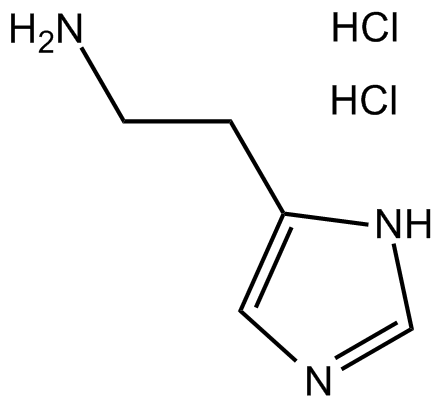All AbMole products are for research use only, cannot be used for human consumption.

Histamine 2HCl is an endogenous ligand for the histamine receptor, which can cause allergic reactions by interacting with H1 receptors, promote acid secretion by interacting with H2 receptors, as well as inhibit histamine release and modulate immune responses by interacting with H3 receptors and H4 receptors. It can be used in studies related to allergy, hyperacidity, sleep disorders, asthma and many other diseases.
| Molecular Weight | 184.07 |
| Formula | C5H9N3.2HCl |
| CAS Number | 56-92-8 |
| Solubility (25°C) | Water ≥ 30 mg/mL |
| Storage | 2-8°C, dry, sealed |
[2] E Kovacova-Hanuskova, et al. Histamine, histamine intoxication and intolerance
[3] Lily P H Yang, et al. Histamine dihydrochloride: in the management of acute myeloid leukaemia
[5] Carlos M Galmarini. Histamine dihydrochloride (subcutaneous) Maxim
| Related Histamine Receptor Products |
|---|
| Dimethindene
Dimethindene is a potent, selective histamine H1 antagonist. |
| ABT-288
ABT-288 is a competitive, potent and selective histamine H3 receptor (H3R) antagonist. |
| A-349821
A-349821 is a histamine H3 receptor antagonist characterized as a radioligand ([3H]-A-349821) for in vivo receptor occupancy assessment. |
| Betazole
Betazole (Ametazole), a pyrazole analogue of histamine, is an orally active histamine H2 receptor agonist. |
| Tiotidine
Tiotidine (ICI 125211) is a potent and selective antagonist of histamine H2-receptor (pA2=7.3-7.8 for guinea-pig right atrium). |
All AbMole products are for research use only, cannot be used for human consumption or veterinary use. We do not provide products or services to individuals. Please comply with the intended use and do not use AbMole products for any other purpose.


Products are for research use only. Not for human use. We do not sell to patients.
© Copyright 2010-2024 AbMole BioScience. All Rights Reserved.
